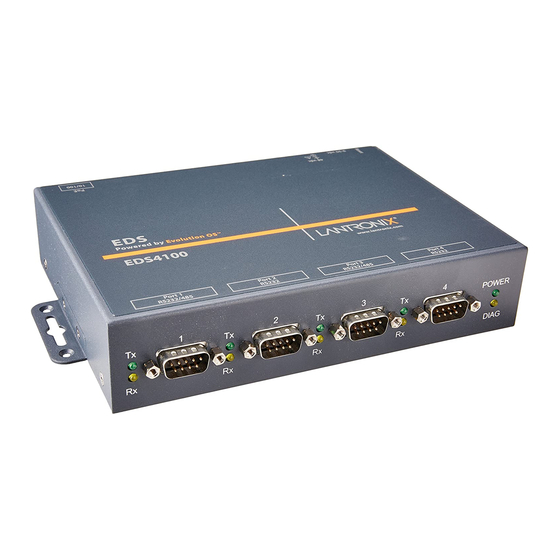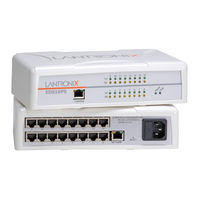
Lantronix EDS4100 Manuals
Manuals and User Guides for Lantronix EDS4100. We have 7 Lantronix EDS4100 manuals available for free PDF download: User Manual, Reference Manual, Quick Start Manual
Lantronix EDS4100 User Manual (163 pages)
EDS Device Servers/Terminal Servers
Table of Contents
-
-
Applications20
-
Evolution os20
-
-
VIP Access21
-
-
-
-
Serial Ports31
-
Leds33
-
Reset Button33
-
-
-
-
-
-
-
-
DNS Settings79
-
FTP Settings81
-
RSS Settings89
-
LPD Settings90
-
Advertisement
Lantronix EDS4100 User Manual (198 pages)
4 Port Device Server
Table of Contents
-
1 : Preface
11 -
-
Features14
-
Evolution os14
-
Applications16
-
-
-
Serial Ports23
-
Leds24
-
Reset Button25
-
-
Tunnel Pages46
-
DNS Page65
-
SNMP Page66
-
FTP Page68
-
Tftp69
-
HTTP Pages70
-
CLI Pages78
-
SSH Pages81
-
SSL Page89
-
XML Pages92
-
Query Port Page106
-
-
IP Sockets Page109
-
System Page116
Lantronix EDS4100 User Manual (175 pages)
EDS Device Servers/Terminal Servers
Table of Contents
-
1 : Preface
11 -
-
-
Features14
-
-
Evolution os15
-
Applications18
-
-
-
-
Serial Ports22
-
Leds23
-
Reset Button24
-
-
-
-
-
Tunnel Pages56
-
Host Page73
-
-
DNS Page76
-
SNMP Page77
-
FTP Page79
-
TFTP Page80
-
Syslog Page81
-
HTTP Pages82
-
RSS Page88
-
LPD Pages89
-
-
Advertisement
Lantronix EDS4100 User Manual (163 pages)
EDS Device Servers and Terminal Servers
Table of Contents
-
Contacts2
-
Figures9
-
-
Evolution os17
-
-
-
-
Serial Ports28
-
Leds30
-
Reset Button31
-
-
-
-
-
Accept Mode58
-
Packing Mode60
-
Connect Mode64
-
AES Keys71
-
-
RSS Settings89
-
LPD Settings90
Lantronix EDS4100 User Manual (158 pages)
EDS Device Servers
Table of Contents
-
1 : Preface
10 -
-
-
Features13
-
-
Evolution os14
-
Applications17
-
-
-
-
Serial Ports21
-
Leds22
-
Reset Button23
-
-
-
-
-
Tunnel Pages52
-
-
DNS Page70
-
SNMP Page71
-
FTP Page72
-
TFTP Page74
-
Syslog Page75
-
HTTP Pages76
-
-
Lantronix EDS4100 Reference Manual (68 pages)
EDS Device Servers
Table of Contents
-
-
Enable Menu10
-
Device Menu26
-
Line Menu31
-
SSH Menu33
-
SSL Menu36
-
Tunnel Menu37
-
-
XML Groups51
-
Index
68
Lantronix EDS4100 Quick Start Manual (6 pages)
Table of Contents
Advertisement






